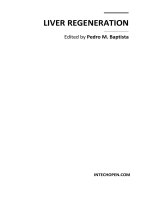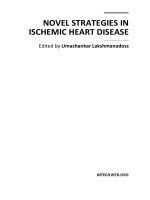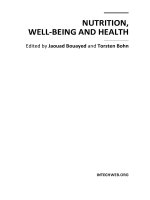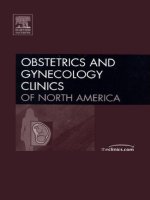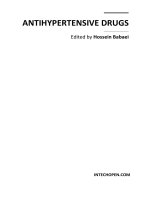Antimicrobial Agents Edited by Varaprasad Bobbarala pdf
Bạn đang xem bản rút gọn của tài liệu. Xem và tải ngay bản đầy đủ của tài liệu tại đây (13.08 MB, 432 trang )
ANTIMICROBIAL AGENTS
Edited by Varaprasad Bobbarala
Antimicrobial Agents
Edited by Varaprasad Bobbarala
Published by InTech
Janeza Trdine 9, 51000 Rijeka, Croatia
Copyright © 2012 InTech
All chapters are Open Access distributed under the Creative Commons Attribution 3.0
license, which allows users to download, copy and build upon published articles even for
commercial purposes, as long as the author and publisher are properly credited, which
ensures maximum dissemination and a wider impact of our publications. After this work
has been published by InTech, authors have the right to republish it, in whole or part, in
any publication of which they are the author, and to make other personal use of the
work. Any republication, referencing or personal use of the work must explicitly identify
the original source.
As for readers, this license allows users to download, copy and build upon published
chapters even for commercial purposes, as long as the author and publisher are properly
credited, which ensures maximum dissemination and a wider impact of our publications.
Notice
Statements and opinions expressed in the chapters are these of the individual contributors
and not necessarily those of the editors or publisher. No responsibility is accepted for the
accuracy of information contained in the published chapters. The publisher assumes no
responsibility for any damage or injury to persons or property arising out of the use of any
materials, instructions, methods or ideas contained in the book.
Publishing Process Manager Vedran Greblo
Technical Editor Teodora Smiljanic
Cover Designer InTech Design Team
First published August, 2012
Printed in Croatia
A free online edition of this book is available at www.intechopen.com
Additional hard copies can be obtained from
Antimicrobial Agents, Edited by Varaprasad Bobbarala
p. cm.
ISBN 978-953-51-0723-1
Contents
Preface IX
Chapter 1 Antibacterial Activity of Naturally
Occurring Compounds from Selected Plants 3
Olgica Stefanović, Ivana Radojević,
Sava Vasić and Ljiljana Čomić
Chapter 2 Future Antibiotic Agents:
Turning to Nature for Inspiration 25
Nataša Radić and Tomaž Bratkovič
Chapter 3 Natural Antimicrobial
Peptides from Eukaryotic Organisms 51
Renaud Condé, Martha Argüello, Javier Izquierdo,
Raúl Noguez, Miguel Moreno and Humberto Lanz
Chapter 4 The Susceptibility of Staphylococcus aureus
and Klebsiella pneumoniae to Naturally
Derived Selected Classes of Flavonoids 73
Johannes Bodenstein and Karen Du Toit
Chapter 5 Antibacterial Activity of Novel Sulfonylureas,
Ureas and Thioureas of 15-Membered Azalides 85
Mirjana Bukvić Krajačić and Miljenko Dumić
Chapter 6 Antimicrobial Activity of Condiments 109
André Silvério and Maria Lopes
Chapter 7 An Alternative Approaches for the
Control of Sorghum Pathogens Using
Selected Medicinal Plants Extracts 129
Varaprasad Bobbarala and
Chandrasekhar K. Naidu
Chapter 8 Antimicrobial Activity of Lectins from Plants 145
Aphichart Karnchanatat
VI Contents
Chapter 9 The Natural Antimicrobial Chromogranins/Secretogranins-
Derived Peptides – Production, Lytic Activity and
Processing by Bacterial Proteases 179
Ménonvè Atindehou, Rizwan Aslam, Jean-François Chich,
Youssef Haïkel, Francis Schneider and Marie-Hélène Metz-Boutigue
Chapter 10 Mechanisms Determining Bacterial
Biofilm Resistance to Antimicrobial Factors 213
Kamila Myszka and Katarzyna Czaczyk
Chapter 11 Antimicrobial Activity of
Endophytes from Brazilian Medicinal Plants 239
Chirlei Glienke, Fabiana Tonial, Josiane Gomes-Figueiredo,
Daiani Savi, Vania Aparecida Vicente, Beatriz H. L. N. Sales Maia
and Yvelise Maria Possiede
Chapter 12 Quinolones: Synthesis and Antibacterial Activity 255
Pintilie Lucia
Chapter 13 Superbugs: Current Trends and Emerging Therapies 273
Amy L. Stockert and Tarek M. Mahfouz
Chapter 14 The Prophylactic Use of
Acidifiers as Antibacterial Agents in Swine 295
V. G. Papatsiros and C. Billinis
Chapter 15 From Synthesis to Antibacterial Activity of Some
New Palladium(II) and Platinum(IV) Complexes 311
Ivana D. Radojević, Verica V. Glođović, Gordana P. Radić,
Jelena M. Vujić, Olgica D. Stefanović, Ljiljana R. Čomić
and Srećko R. Trifunović
Chapter 16 Antibacterial Agents in Dental Treatments 333
Saeed Rahimi, Amin Salem Milani, Negin Ghasemi
and Shahriar Shahi
Chapter 17 Andrographis paniculata (Burm.f) Wall. ex Ness:
A Potent Antibacterial Plant 345
Qamar Uddin Ahmed, Othman Abd. Samah
and Abubakar Sule
Chapter 18 Antibacterial Agents from Lignicolous Macrofungi 361
Maja Karaman, Milan Matavulj
and Ljiljana Janjic
Chapter 19 Antibacterial Agents in Textile Industry 387
Sheila Shahidi and Jakub Wiener
Chapter 20 Silver Nanoparticles: Real Antibacterial Bullets 407
G. Thirumurugan and M. D. Dhanaraju
Preface
This book contains precisely referenced chapters, emphasizing antibacterial agents
with clinical practicality and alternatives to synthetic antibacterial agents through
detailed reviews of diseases and their control using alternative approaches. The book
aims at explaining bacterial diseases and their control via synthetic drugs replaced by
chemicals obtained from different natural resources which present a future direction
in the pharmaceutical industry. The book attempts to present emerging low cost and
environmentally friendly drugs that are free from side effects studied in the
overlapping disciplines of medicinal chemistry, biochemistry, microbiology and
pharmacology.
Varaprasad Bobbarala
Chief Scientist at Krisani Biosciences
India
1
Antibacterial Activity of Naturally
Occurring Compounds from Selected Plants
Olgica Stefanović, Ivana Radojević, Sava Vasić and Ljiljana Čomić
Labaratory of Microbiology, Department of Biology and Ecology,
Faculty of Science, University of Kragujevac, Kragujevac
Serbia
1. Introduction
Man is in constant contact with a large number of different bacteria which temporarily or
permanently inhibit his body creating temporary or permanent community. Relations which
are thus established are various and very complex, from those positive to those whose
consequences for man are extremely negative. Very often, both on and in man’s body,
bacteria which have the ability to cause an infection are present. This ability of pathogenic
bacteria is reflected in possession of certain pathogenicity factors. A set of factors which
enable successful invasion and damage of the host are: toxins, surface structures and
enzymes. Between the host and the pathogen very complex relations are established whose
income depends on host’s characteristics as well as on pathogen’s characteristics.
Infections caused by bacteria can be prevented, managed and treated through anti-bacterial
group of compounds known as antibiotics. Antibiotics are natural, semi-synthetic or
synthetic compounds that kill or inhibit the growth of bacteria. When bacteria are exposed
to an antibiotic, they doubly respond: i) they are sensitive what cause the inhibition of their
growth, division and death or ii) they can remain unaffected or resistant.
The resistance of bacteria to antibiotics can be natural (intrinsic) or acquired. Natural
resistance is achieved by spontaneous gene mutation. The acquired resistence occurs after
the contact of bacteria with an antibiotic as a result of adaptation of a species to adverse
environmental conditions. In such population, an antibiotic as a selective agent, acts on
sensitive individuals, while resistant survive and become dominant. Bacteria gain antibiotic
resistance due to three reasons namely: (i) modification of active site of the target resulting
in reduction in the efficiency of binding of the drug, (ii) direct destruction or modification of
the antibiotic by enzymes produced by the organism or, (iii) efflux of antibiotic from the cell
(Sheldon, 2005). The evolution of antibacterial resistance in human pathogenic and
commensal microorganisms is the result of the interaction between antibiotic exposure and
the transmission of resistance within and between individuals. It is especially interesting the
phenomenon of horizontally gene transfer. Extrachromosomal DNA material, so-called
plasmids, often carry genes of resistance and can transfer information within and between
the individuals of the same or related bacterial species, thus also spreading the resistance.
Transformation, transduction and conjugation represent the horizontal gene transfer
mechanisms of resistance between the bacteria.
Antimicrobial Agents
2
Having in mind the current progress of resistance spreading and resilience of larger and
larger number of bacteria to traditional antibiotics as well as a way of transmitting the gene
of resistance, above all via plasmids, one can conclude that the ability of obtaining
bacterium resistance to antibiotics represents a very dynamic and unpredictable
phenomenon. For that reason, bacterial resistance to antibiotics represents a major health
problem. Solving this problem and search for new sources of antimicrobial agents is a
worldwide challenge and the aim of many researches of scientific and research teams in
science, academy institutions, pharmaceutical companies. One of the approaches in solving
this issue is testing the biologically active compounds of plant origin.
1.1 Plants as potential antibacterial agents
Healing potential of plants has been known for thousands of years. Medicinal use of plants
and their products was passed down from generation to generation in various parts of the
world throughout its history and has significantly contributed to the development of
different traditional systems of medicine. Even today, the World Health Organization
(WHO) has estimated that approximately 80% of the global population relies on traditional
herbal medicines as part of standard healthcare (Foster et al., 2005). Many drugs presently
prescribed by physicians are either directly isolated from plants or are artificially modified
versions of natural products. In Western countries, approximately 25% of the drugs used are
of natural plant origin (Payne et al., 1991).
Plants produce a whole series of different compounds which are not of particular
significance for primary metabolism, but represent an adaptive ability of a plant to adverse
abiotic and biotic environmental conditions. They can have a remarkable effect to other
plants, microorganisms and animals from their immediate or wider environment. All these
organic compounds are defined as biologically active substances, and generally represent
secondary metabolites, given the fact that they occur as an intermediate or end products of
secondary plant metabolism. These secondary metabolites, apart from determining unique
plant traits, such as: colour and scent of flowers and fruit, characteristic flavour of spices,
vegetables, they also complete the functioning of plant organism, showing both biological
and pharmacological activity of a plant. Therefore, medicinal properties of plants can be
attributed to secondary metabolites (Hartmann, 2008).
1.1.1 Antibacterial secondary metabolites
It is known and proved by in vitro experiments that plants produce a great number of
secondary metabolites that have antimicrobial activity (Iwu et al., 1999; Cowan, 1999; Rios &
Recio, 2005; Cos et al., 2006). These plant-formed antibiotics have been classified as
phytoanticipins, which are preformed inhibitory compounds, or phytoalexins, which are
derived from precursors via de novo synthesis in response to microbial attack (VanEtten et
al., 1994). Antibacterial secondary metabolites are usually classified in three large molecule
families: phenolics, terpenes and alkaloids.
The phenolics and polyphenols are one of the largest groups of secondary metabolites that
have exhibited antimicrobial activity. Important subclasses in this group of compounds
include phenols, phenolic acids, quinones, flavones, flavonoids, flavonols, tannins and
coumarins. Phenols are a class of chemical compounds consisting of a hydroxyl functional
Antibacterial Activity of Naturally Occurring Compounds from Selected Plants
3
group (-OH) attached to an aromatic phenolic group. The site(s) and number of hydroxyl
groups on the phenol group are thought to be related to their relative toxicity to
microorganisms, with evidence that increased hydroxylation results in increased toxicity
(Geissman, 1963, as cited in Cowan, 1999). Quinones have aromatic rings with two ketone
substitutions. Quinones have a potential to form irreversible complex with nucleophilic amino
acids in proteins (Stern et al., 1996, as cited in Cowan, 1999). This could explain their
antibacterial properties. Probable targets in the microbial cell are surface-exposed adhesins,
cell wall polypeptides and membrane-bound enzymes. Flavones are phenolic structures
containing one carbonyl group. The addition of a 3-hydroxyl group yields a flavonol.
Flavonoids are also hydroxylated phenolic substances but occur as a C6-C3 unit linked to an
aromatic ring. Flavones, flavonoids and flavonols have been known to be synthesized by
plants in response to microbial infection so it is not surprising that they have been found, in
vitro, to be effective antimicrobial substances against a wide array of microorganisms (Dixon et
al., 1983, as cited in Cowan, 1999). Their activity is probably due to their ability to complex
with extracellular and soluble proteins and to complex with bacterial cell walls. Lipophilic
flavonoids may also disrupt microbial membranes (Tsuchiya et al., 1996, as cited in Cowan,
1999). Tanins, a group of polymeric phenolic substances, are found in almost every plant part:
bark, wood, leaves, fruits and roots. They are divided into two groups, hydrolyzable and
condensed tannins. In plant tissue, tannins have been synthesized and accumulated after
microbial attack. Their mode of antimicrobial action may be related to their ability to inactivate
microbial adhesins, enzymes, cell envelope transport proteins, because of a property known as
astringency. Coumarins are benzo-α-pyrones and could be categorised as: simple coumarins
and cyclic coumarins (furanocoumarins and pyranocoumarins) (Ojala, 2001). Coumarins have
been found to stimulate macrophages, which could have an indirect negative effect on
infections (J. R. Casley-Smith & J. R.Casley-Smith, 1997, as cited in Cowan, 1999).
Terpenes are a large and varied class of organic compounds built up from isoprene
subunits, while the terpenoids are oxygen-containing analogues of the terpenes. According
to number of isoprene subunits, there are monoterpenes (C10), sesquiterpenes (C15),
diterpenes (C20), triterpenes (C30), tetraterpenes (C40) and polyterpenes (Kovacevic, 2004).
Monoterpenes, diterpenes and sesquiterpenes are the primary constituents of the essential
oils. The mechanism of antibacterial action of terpenes is not fully understood but is
speculated to involve membrane disruption by the lipophilic compounds. Accordingly,
Mendoza et al., 1997 found that increasing the hydrophilicity of kaurene diterpenoids by
addition of a methyl group drastically reduced their antimicrobial activity. (Mendoza et al.,
1997, as cited in Cowan, 1999).
Alkaloids, one of the earliest isolated bioactive compounds from plants, are heterocyclic
nitrogen compounds. They are derived from amino acids, and the nitrogen gives them
alkaline properties. The mechanism of antibacterial action is attributed to their ability to
intercalate with DNA, inhibition of enzymes (esterase, DNA-, RNA-polymerase), inhibition
of cell respiration (Kovacevic, 2004).
1.1.2 Plant extracts as potential antibacterial agents
The screening of plant extracts has been of great interest to scientists for the discovery of
new compound effective in the treatment of bacterial infection. Plant extracts exhibit:
Antimicrobial Agents
4
• direct antibacterial activity showing effects on growth and metabolism of bacteria
• indirect activity as antibiotic resistance modifying compounds which, combined with
antibiotics, increase their effectiveness.
A great number of reports concerning the antibacterial screening of plant extracts have
appeared in the literature. Examples of such articles include studies of medicinal plants from
different geographical regions: Brazil (Alves et al., 2000), Argentina (Salvat et al., 2000),
Columbia (López et al., 2001); India (Perumal et al., 1998; Ahmad & Beg, 2001), China (Zuo et
al., 2008), Turkey (Sokman et al., 1999; Uzun et al., 2004); Greece (Skaltsa et al., 2003), Spain
(Ríos et al., 1987; Recio et al., 1989), Serbia (Stefanovic et al., 2009a; Stefanovic et al., 2009b,
Stanojevic et al., 2010a; Stanojevic et al., 2010b; Stojanovic-Radic et al., 2010; Stefanovic et al.,
2011; Stefanovic et al., 2012); Africa (Atindehou et al., 2002; Konning et al., 2004; Chah et al.,
2006); Australia (Palombo & Semple, 2001). According to published data, the plant extracts
exhibited the activity against a great number of bacterial species (Gram positive and Gram
negative strains; sensitive and resistant, pathogens and opportunistic pathogens). The
experiments involved the standard strains as well as the clinical isolates of pathogenic bacteria,
as more realistic test organisms for estimation of antibacterial activity. Plant extracts were
prepared from fresh or dried plant material using conventional extraction methods (Soxhlet
extraction, maceration, percolation). Extraction is process of separation of active compounds
from plant material using different solvents. During extraction, solvents diffuse into the plant
material and solubilise compounds with similar polarity. At the end of the extraction, solvents
have been evaporated, so that an extract is a concentrated mixture of plant active compounds.
Successful extraction is largely dependent on the type of solvent used in the extraction
procedure. The most often tested extracts are: water extract as a sample of extract that
primarily used in traditional medicine and extracts from organic solvents such as methanol,
ethanol as well as ethyl acetate, acetone, chloroform, dichlormethane (Ncube et al., 2008).
Diffusion and dilution method are two types of susceptibility test used to determine the
antibacterial efficacy of plant extracts. Diffusion method is a qualitative test which allows
classification of bacteria as susceptible or resistant to the tested plant extract according to
size of diameter of the zone of inhibition. In dilution method, the activity of plant extracts is
determined as Minimum Inhibitory Concentration (MIC). MIC is defined as the lowest
concentration able to inhibit bacterial growth. In broth-dilution methods, turbidity and
redox-indicators are most frequently used for results reading. Turbidity can be estimated
visually or spectofotometrically while change of indicator colour indicate inhibition of
bacterial growth (Cos et al., 2006).
2. Evaluation of antibacterial activity of selected plant species
Considering a large number of still insufficiently or incompletely examined species in the plant
world; in inexhaustible possibilities of modifying natural substances, there is a need for
systematic research and even greater affirmation of plant antimicrobial compounds. In this
study the in vitro antibacterial activity of selected plant species was tested and evaluated the
potential use of their extracts as a source of antibacterial compounds. The experiment involved
water, ethanol, ethyl acetate and acetone extracts from 10 plant species belonging to 4 the most
important plant families. The following plants were used: Cychorium intybus L. (Asteraceae);
Salvia officinalis L., Melissa officinalis L., Clinopodium vulgare L. (Lamiaceae); Torilis anthriscus L.
(Gmel), Aegopodium podagraria L. (Apiaceae); Cytisus nigricans L., Cytisus capitatus Scop.,
Antibacterial Activity of Naturally Occurring Compounds from Selected Plants
5
Melilotus albus Medic., Dorycnium pentaphyllum Vill. (Fabaceae). In general, the plants are
annual or perennial, herbaceous or shrubby, widespread in Europe. They are rich in secondary
metabolites from a group of phenols, flavonoids, coumarins, tannins, terpenes. It is known that
different solvents extracted different groups of secondary metabolites, hence different types of
extracts were prepared. The plants, as potential candidates for antibacterial agents, were
selected on the base of three criteria: i) use in traditional medicine as antiseptic agents, ii)
random selection followed by chemical screening (ii) insufficient antibacterial scientific data.
Detailed description of known traditional uses, in vitro found biological activities and the
chemical constituent is shown in Table 1.
Plant
species
Traditional
use
Biological
activity
Chemical
constituents
Fam.
Asteraceae
Cichorium
intybus
improving digestion,
for a diarrhea,
as diuretic,
for cleansing the liver and
benefiting the gallbladder
(Saric, 1989)
antibacterial,
antifungal activity
(Petrovic et al.,
2004; Rani &
Khullar, 2004;
Mares et al., 2005)
sesquiterpene lactones
(Zidorn, 2008), inulin ,
flavonoids, coumarins
(Dem’yanenko & Dranik,
1971), tannins, phenolic acids (
Sareedenchai & Zidorn, 2010 )
Fam.
Lamiaceae
Salvia
officinalis
for disorders of the
digestive system,
as antiseptic for sore
throats, ulcers,
to treat insect bites, mouth
and gum infections and
vaginal discharge
for night sweats (Saric,
1989)
antibacterial,
antifungal,
antiviral activity (
Velickovic et al.,
2003; Nolkemper
et al., 2006;
Horiuchi et al.,
2007; Weckesser et
al., 2007)
simple phenols, phenolic acids,
flavonoids, coumarins,
tannins, terpenoids (Lu & Foo,
1999; 2002; Durling et al., 2007)
Melissa
officinalis
to reduce indigestion and
flatulence,
as a mild sedative,
to treat headache,
migraine, nervous tension
and insomnia,
to treat cold, fever and
cough (Saric, 1989)
antibacterial,
antifungal,
antiviral activity (
Iauk et al., 2003;
Ertürk, 2006;
Nolkemper et al.,
2006)
flavonoids ( Herodež et al.,
2003; Patora & Klimek , 2002),
phenolic acids (Herodež et al.,
2003; Canadanović –Brunet et
al., 2008), simple phenols,
tannins (Hohmann et al., 1999)
Clinopodium
vulgare
as a heart tonic,
an expectorant,
as a diuretic (Saric, 1989)
as an antiseptic for
wounds and injuries
(Opalchenova and
Obreshkova, 1999).
antibacterial
activity
(Opalchenova &
Obreshkova, 1999)
polyphenols ( Kratchanova et
al., 2010), cis-cinnamic, trans-
cinnamic, p-coumaric and
ferulic acid (Obreshkova et al.,
2001), saponins ( Miyase &
Matsushima, 1997 )
Antimicrobial Agents
6
Plant
species
Traditional
use
Biological
activity
Chemical
constituents
Fam.
Apiaceae
Aegopodium
podagraria
for gout and sciatics
(Saric, 1989)
antibacterial,
antifungal activity
( Ojala et al., 2000;
Garrod et al.,
1979)
furano-coumarins ( Ojala et al.,
2000), polyacetilenes,
falcarindiol ( Christensen &
Brandt, 2006), flavonoids
(Cisowski, 1985)
Torilis
anthriscus
syn. Torilis
japonica
an expectorant and tonic
(Duke et al., 2002), for
flatulence (Manandhar,
2002)
antibacterial
activity ( Cho et
al., 2008),
anti-protozoal
activity ( Youn et
al., 2004)
coumarins (3),
sesquiterpenoids (guaiane,
humulene, germacrane,
eudesmane) (Kitajima et al.,
2002 )
Fam.
Fabaceae
Melilotus
albus
as ointments for external
ulcers,
as an anticoagulant agent
(Saric, 1989)
antibacterial
activity
(Acamovic-
Djokovic et al.,
2002)
coumarins (Stoker, 1964),
saponins (Khodakov et al.,
1996)
Dorycnium
pentaphyllum
No data antibacterial
activity (Stamatis,
2003)
phenylbutanone glucosides
(dorycnioside), flavonoids,
(Kazantzoglou et al., 2004)
Cytisus
capitatus
No data No data alkaloids (l-sparteine,
sarothamnine, genisteine,
lupanine, oxysparteine) (Wink
et al., 1983)
Cytisus
nigricans
No data No data alkaloids ( Wink et al., 1983)
Table 1. Traditional uses, biological activities and chemical constituents of selected plant
species
2.1 Materials and methods
2.1.1 Plant material
The aerial parts of Clinopodium vulgare, Aegopodium podagraria, Torilis anthriscus, Dorycnium
pentaphyllum, Melilotus albus, Cytisus nigricans and Cytisus capitatus were collected from the
different regions of Serbia, during summer 2006 and 2009 while Cichorium intybus (root),
Salvia officinalis (leaves) and Melissa officinalis (leaves) were supplied from the commercial
source. Identification and classification of the plant material was performed at the Faculty of
Science, University of Kragujevac. The voucher specimens of the plants are deposited in the
Herbarium of the Faculty of Science, University of Kragujevac. The collected plant materials
were air-dried under shade at room temperature and then ground into small pieces which
were stored into paper bags at room temperature.
Antibacterial Activity of Naturally Occurring Compounds from Selected Plants
7
2.1.2 Extraction
Dried, ground plant material was extracted by direct maceration with water, ethanol, ethyl
acetate and acetone. Briefly, 30g of plant material was soaked with 150ml of solvent for 24h
at room temperature. During 24 hours, targeted compounds from plant material were
extracted by the solvent. After that the resulting extract was filtered through filter paper
(Whatman no.1). The residue from the filtration was extracted again, twice, using the same
procedure. The filtrates obtained were combined and then evaporated to dryness using a
rotary evaporator at 40°C, for water extracts heating on a water bath. The crude plant
extracts are stored at -20°C. Before the testing, stock solutions of the crude extracts were
obtained by dissolving in dimethyl sulfoxide (DMSO) and then diluted into nutrient liquid
medium to achieve a concentration of 10% DMSO. The groups of secondary metabolites
which are expected in prepared plant extracts are given in Table 2.
Water extract Ethanol extract Ethyl acetate extract Acetone extract
Simle phenols Simle phenols Simle phenols Simle phenols
Phenolic acids Phenolic acids Phenolic acids Phenolic acids
Flavonoids Flavonoids Flavonoids Flavonoids
Quinones Quinones Quinones Quinones
Tannins Tannins Tannins Tannins
Coumarins Coumarins
Saponins Saponins
Table 2. The expected groups of plant secondary metabolites (according to Kovacevic, 2004)
2.1.3 Microorganisms
The following bacteria were used: Staphylococcus aureus ATCC 25923, Escherichia coli ATCC
25922, Pseudomonas aeruginosa ATCC 27853 and clinical isolate of Staphylococcus aureus
(PMFKg-B30), Bacillus subtilis (PMFKg-B2), Enterococcus faecalis (PMFKg-B22), Enterobacter
cloaceae (PMFKg-B23), Klebsiella pneumoniae (PMFKg-B26), Escherichia coli (PMFKg-B32),
Pseudomonas aeruginosa (PMFKg-B28) and Proteus mirabilis (PMFKg-B29). All clinical isolates
were a generous gift from the Institute of Public Health, Kragujevac. Bacteria are stored in
microbiological collection at the Laboratory of Microbiology (Faculty of Science, University
of Kragujevac).
Bacterial suspension were prepared from overnight cultures by the direct colony method.
Colonies were taken directly from the plate and suspent into 5ml of sterile 0,85% saline. The
turbidity of initial suspension was adjusted comparing with 0,5 Mc Farland standard (0,5 ml
1,17% w/v BaCl
2
× 2H
2
O + 99,5 ml 1% w/v H
2
SO
4
) (Andrews, 2001). When adjusted to the
turbidity of a 0,5 Mc Farland standard, a suspension of bacteria contains about 10
8
colony
forming units (CFU)/ml. Ten-fold dilutions of initial suspension were additionally prepared
into sterile 0,85% saline to achieve 10
6
CFU/ml.
2.1.4 Microdilution method
Antibacterial activity was tested by determining the minimum inhibitory concentration (MIC)
using microdilution plate method with resazurin (Sarker et al., 2007). Briefly, the 96-well
Antimicrobial Agents
8
microplate was prepared by dispensing 100 μL of Mueller-Hinton broth (Torlak, Belgrade)
into each well. A 100 μL from the stock solution of tested extract (concentration of 40mg/ml)
was added into the first row of the plate. Then, two-fold, serial dilutions were performed by
transferring 100 μl of solution from one row to another, using a multichannel pipette. The
obtained concentration range was from 20 mg/ml to 0.156 mg/ml. Ten microlitres of each 10
6
CFU/ml bacterial suspension was added to wells. Finally, 10 μL of resazurin solution was
added. Resazurin is an oxidation-reduction indicator used for the evaluation of microbial
growth. It is a blue non-fluorescent dye that becomes pink and fluorescent when reduced to
resorufin by oxidoreductases within viable cells (Figure 1.). The inoculated plates were
incubated at 37°C for 24h. MIC was defined as the lowest concentration of the tested plant
extracts that prevented resazurin color change from blue to pink.
Antibiotic cephalexin, dissolved in Mueller-Hinton broth, was used as positive control.
Solvent control test was performed to study an effect of 10% DMSO on the growth of
bacteria. It was observed that 10% DMSO did not inhibit the growth of bacteria. Each test
included growth control and sterility control. All tests were performed in duplicate and
MICs were constant.
2.1.5 Statistical analysis
All statistical analyses were performed using SPSS package. Mean differences were
established by Student’s t-test. In all cases p values <0.05 were considered statistically
significant.
Fig. 1. Plate after 24 h in resazurin assay (pink colour indicates growth and blue means
inhibition of growth)
3. Results and discussion
In vitro antibacterial activity of different plant extracts from 10 selected plants was tested in
relation to 11 bacterial strains. Intensity of antibacterial activity depended on the species of
Antibacterial Activity of Naturally Occurring Compounds from Selected Plants
9
bacteria, plant species and the type of extract. The MIC values were in range from 0.019
mg/ml to >20mg/ml. In relation to positive control (cephalexin MIC 0. 00156 - >1mg/ml),
the extracts showed lower activity. In general, according to obtained results, the following
remarks could be made:
• Detectable MICs were noticed in 100% of tested bacteria for Cichorium intybus, 70% for
Salvia officinalis, 90% for Melissa officinalis, 83, 33% for Clinopodium vulgare, 100% for
Torilis anthriscus, 33, 33% for Aegopodium podagraria, 96, 67% for Cytisus nigricans, 76,
67% for Cytisus capitatus, 60% for Melilotus albus and 96, 67% for Dorycnium
pentaphyllum.
• Among tested plants, the best inhibitory effects showed acetone extract from Salvia
officinalis, ethyl acetate and acetone extract from Cichorium intybus and ethanol extract
from Aegopodium podagraria. Moderate antibacterial activity exhibited Melissa officinalis,
Clinopodium vulgare (ethyl acetate and acetone extract), Torilis anthriscus, Cytisus
nigricans, Cytisus capitatus and Dorycnium pentaphyllum while low activity showed
Clinopodium vulgare (ethanol extract), Melilotus albus and Aegopodium podagraria (water
and ethyl acetate extract).
• Water extracts were less active than ethanol, ethyl acetate and acetone extracts.
• The antibacterial activity of the tested extracts was closely associated with present
secondary metabolites.
• The Gram-positive bacteria were more sensitive than the Gram-negative bacteria. The
reason for higher sensitivity of the Gram-positive bacteria than Gram-negative bacteria
could be ascribed to their differences in cell wall constituents and their arrangement.
The Gram-positive bacteria contain a peptidoglycan layer, which is an ineffective
permeability barrier while Gram-negative bacteria are surrounded by an additional
outer membrane carrying the structural lipopolysaccharide components, which makes
it impermeable to lipophilic solutes and porins constitute a selective barrier to the
hydrophilic solutes (Nikaido, 2003).
• Among tested bacteria, the most sensitive bacteria were Gram positive bacteria: B.
subtilis and S. aureus ATCC 25923. Susceptibility of E. cloaceae, Ent. faecalis, K.
pneumoniae, S. aureus, Ps. aeruginosa ATCC 27853 was moderate. Clinical isolate of Gram
negative bacteria, Ps. aeruginosa, P. mirabilis, E. coli, exhibited low susceptibility or
resistance.
3.1 Antibacterial activity of Cichorium intybus
The results of antibacterial activity of ethanol, ethyl acetate and acetone extract from
Cichorium intybus are presented on the Figure 2. Extracts showed different activity. Ethanol
extract acted at concentrations of 2.5 mg/ml to 20mg/ml; ethyl acetate from 1.09 mg/ml to
8.75 mg/ml; acetone extract from 2.5 mg/ml to 5 mg/ml. Antibacterial activity of ethyl
acetate and acetone extract is more pronounced than ethanol extract. Similar results were
obtained by Nandagopal & Ranjitha Kumari, 2007, among tested extracts, ethyl acetate was
one of the more active. Statistic analysis confirms the presented results. Activity of ethyl
acetate (p
EtAc
=0.001) and acetone (p
AcOH
=0.002) extract was statistically significantly higher
that the activity of ethanol extract. Acetone extract was the most active (p=0.018).
The tested bacteria manifested different sensitivity level to the tested extracts. MIC values
were ranged from 1.09 mg/ml to 20 mg/ml. The most sensitive bacterium to the tested
Antimicrobial Agents
10
Fig. 2. Antibacterial activity of Cichorium intybus extracts expressed as MIC values (mg/ml)
extracts was Pseudomonas aeruginosa ATCC 27853. MIC values for this bacterium were 2.5
mg/ml for ethanol and acetone extract, and 1.09 mg/ml for ethyl acetate extract. Bacteria
Bacillus subtilis, Enterobacter cloacae, Staphylococcus aureus ATCC 25923 with 2.18 mg/ml, 2.5
mg/ml and 5 mg/ml values also manifested significant sensitivity. Proteus mirabilis,
Escherichia coli ATCC 25922, according to ethanol extract, have showed the least sensitivity
(MIC = 20 mg/ml), while they were more sensitive to the other two extracts. Similar results
were obtained by other scientists. Petrović et al., 2004 noted the inhibitory effect of chicory
extract also on phypopathogenic and human pathigenic bacteria. Acroum et al., 2009
showed the effect of methanol extract on Gram-positive bacteria (Bacillus subtilis, Bacillus
cereus, Staphylococcus aureus) with the MIC values of 0.010 mg/ml and 0.075 mg/ml while
the extract did not act on Gram-negative bacteria Escherichia coli, Pseudomonas aeruginosa,
Klebsiella pneuminiae.
3.2 Antibacterial activity of Salvia officinalis
The acetone extract was the most reactive extract at this testing (p
EtOH
=0,004; p
EtAc
=0,001),
while there was no statistically significant difference between ethanol and ethyl acetate
extracts in acting. Ethanol and ethyl acetate extract showed the activity at concentrations
from 2.5 mg/ml to >20 mg/ml, and acetone extract from 0.02 mg/ml to 20 mg/ml (Figure
3.). The reason for good results which acetone extract showed can also be saught in the fact
that acetone is a good extractant, of low toxicity and high extractional capacity (Eloff, 1998).
Similar results for acetone extract were also obtained by (Horiuchi et al., 2007), MIC values
were from 256 µg/ml tо 512 µg/ml.
The tested bacteria, except for Pseudomonas aeruginosa and Escherichiа coli, showed
a significant sensitivity in relation to acetone extract. MIC values were below 1 mg/ml.
Antibacterial Activity of Naturally Occurring Compounds from Selected Plants
11
Fig. 3. Antibacterial activity of Salvia officinalis extracts expressed as MIC values (mg/ml)
Gram-positive bacteria were more sensitive than Gram-negative bacteria. MICs for Bacillus
subtilis were showed at 5 mg/ml for ethanol extract, 10 mg/ml for ethyl acetate extract and
0.03 mg/ml for acetone extract. For Staphylococcus aureus, MIC of ethanol extract was 5
mg/ml, ethyl acetate 20 mg/ml and acetone 0.31 mg/ml, while Staphylococcus aureus ATCC
25923, as G
+
bacterium, only showed sensitivity in relation to acetone extract (MIC = 0.15
mg/ml). Growth of the most of G
-
bacteria was not inhibited by action of ethanol and ethyl
acetate extract on tested concentrations. Similar results were obtained by Veličković et al.,
2003 where ethanol extract reacted poorly on G
-
in relation to G
+
bacteria. The exception is
Pseudomonas aeruginosa ATCC 27853, which is next to Bacillus subtilis, the most sensitive
bacterium to tested extracts.
3.3 Antibacterial activity of Melissa officinalis
The results of antibacterial activity of water, ethanol and ethyl acetate extract from Melissa
officinalis are presented on the Figure 4. The tested extracts showed equable antibacterial
activity, based on the results of statistic analysis, no difference was noted (p>0.05). Water
extract acted in the interval from 0.31 mg/ml tо 20 mg/ml; ethanol extract from 0.62
mg/ml to >20 mg/ml, and ethyl acetate extract from 1.25 mg/ml to 20 mg/ml. Ethanol
extract did not act on three species of Gram-negative bacteria. Antimicrobial activity of
different Melissa officinalis extracts was also tested by other scientists who showed
different level of antimicrobial activity with their research (Uzun et al., 2004; Ertürk, 2006;
Iauk et al., 2003).
The tested bacteria showed sensitivity at different concentrations. The concentrations were
ranged from 0.31 tо 20 mg/ml. The greatest sensitivity was noted for standard strains:
Staphylococcus aureus; Escherichia coli and Pseudomonas aeruginosa only to water extract.
Antimicrobial Agents
12
Fig. 4. Antibacterial activity of Melissa officinalis extracts expressed as MIC values (mg/ml)
The most tested bacteria showed sensitivity at 10 mg/ml for ethyl acetate extract. Escherichia
coli, Pseudomonas aeruginosa and Proteus mirabilis showed resistance to ethanol extract.
Weaker activity of lemon balm to mentioned Gram-negative bacterium was also noted in the
work of Canadanović-Brunet et al., 2008.
3.4 Antibacterial activity of Clinopodium vulgare
The extracts manifested different level of antibacterial activity, the results are shown on the
Figure 5. The ethanol extract acted in concentrations from 1.25 mg/ml tо >20 mg/ml, ethyl
acetate and acetone extract from 0.62 mg/ml tо 20 mg/ml. Ethyl acetate and acetone extract
acted better than ethanol extract. Statistically significant difference was noted (p
ЕtAc
=0.015 и
p
AcOH
=0.018). Between ethyl acetate and acetone extract no statistically significant difference
was noted in the activity (p=0.756).
The tested bacteria in most of the cases showed sensitivity at 10 mg/ml and 20 mg/ml.
Gram-positive bacteria Bacillus subtilis and Staphylococcus aureus ATCC 25923 were the
most sensitive to the action of Clinopodium vulgare extracts. MIC values were in the
interval from 0.62 mg/ml tо 2.5 mg/ml. Klebsiella pneumoniae, Staphylococcus aureus,
Enterococcus faecalis, Escherichia coli and Pseudomonas aeruginosa manifested the resistance
to the tested concentrations of ethanol extract. Opalchenova & Obreshkova, 1999 showed
the action of ethanol extract to G
+
and G
-
bacteria but only at 5% of extract’s
concentration, while Sarac & Ugur, 2007 did not notice the action of ethanol extract to the
tested bacteria. These results are in accordance with the shown activity of ethanol extract
in this work.
Antibacterial Activity of Naturally Occurring Compounds from Selected Plants
13
Fig. 5. Antibacterial activity of Clinopodium vulgare extracts expressed as MIC values (mg/ml)
3.5 Antibacterial activity of Torilis anthriscus
Among the tested extracts, the most active was ethanol extract, then ethyl acetate, and the
weakest water extract. Statistically significant difference was noted between the activity of
ethanol extract, on one hand, and ethyl acetate and water extract on the other hand (p
H20
=
0.008; p
EtAc
= 0.032). MIC values were ranged in the interval from 1.25 mg/ml to 20 mg/ml.
The bacteria showed different level of sensitivity to the tested extracts (Figure 6.). They were
the most sensitive to ethanol extract (MIC for most of the bacterium was 5 mg/ml), and then
to ethyl acetate extract (MIC for most of the bacterium was 10 mg/ml). Most of the bacteria
showed weak sensitivity to water extract with MIC values of 20 mg/ml. For Staphylococcus
aureus ATCC 25923, Pseudomonas aeruginosa ATCC 27853 and Staphylococcus aureus, water
extract acted at lower concentrations (MIC = 2.5 and 10 mg/ml). The most sensitive
bacterium was Staphylococcus aureus ATCC 25923, growth inhibition of this bacterium was
noted at 1.25 mg/ml and 2.5 mg/ml.
Antibacterial activity of T. anthriscus extracts is not explored enough. Inhibitory effect was
tested on phytopathogenic bacteria and especially the action of water, ethanol and ethyl
acetate extract was shown on Pseudomonas glycinea (Brkovic et al., 2006). Methanol extract of
fruits slowed germination of spores down and inhibited the growth of vegetative cells of
Bacillus subtilis (Cho et al., 2008).
3.6 Antibacterial activity of Aegopodium podagraria
The results of antibacterial activity of water, ethanol and ethyl acetate extract from
Aegopodium podagraria are presented on the Figure 7. The extracts showed low antibacterial
Antimicrobial Agents
14
Fig. 6. Antibacterial activity of Torilis anthriscus extracts expressed as MIC values (mg/ml)
Fig. 7. Antibacterial activity of Aegopodium podagraria extracts expressed as MIC values
(mg/ml)
Antibacterial Activity of Naturally Occurring Compounds from Selected Plants
15
activity. Only the ethanol extract activity stands out in relation to water extract, which was
confirmed by statistis analysis (p=0.035). Ethanol extract inhibited the growth of most of the
bacteria. Water extract only acted on two bacteria, and ethyl acetate extract on four bacteria.
Ethanol turned the best extractant of active compounds from this plant.
The tested bacteria showed significant sensitivity to ethanol extract, exceptions were
Escherichia coli ATCC 25922 and Pseudomonas aeruginosa ATCC 27853. Growth inhibition
occurred at concentrations from 0.62 mg/ml tо 5 mg/ml. All bacteria, except Pseudomonas
aeruginosa ATCC 27853 and Staphylococcus aureus ATCC 25923, were resistant to water
extract, while Escherichia coli ATCC 25922 was resistant to all three extracts. Bacteria did not
show any significant sensitivity to ethyl acetate extract. Ethyl acetate extract acted on
Enterobacter cloacae, Klebsiella pneumoniae, Pseudomanas aeruginosa ATCC 27853 and
Staphylococcus aureus ATCC 25923. Staphylococcus aureus ATCC 25923 was the most sensitive
bacterium to A. podagraria extracts.
Ojala et al., 2000 tested methanol extract of A. podagraria on G
+
, G
-
bacteria, yeasts and molds
and only partial effect on Bacillus subtilis, Staphylococcus aureus, Staphylococcus epidermidis and
Pseudomonas aeruginosa was noted as well as on Fusarium culmorum and Heterobasidion annosum,
phytopathogenic fungi. Brkovic et al., 2006 also noted the effect on phytopathogenic bacteria.
Similar results were obtained for methanol extract (Ojala et al., 2000) and for ethanol extract in
this study were expected since the methanol and ethanol are solvents of similar polarity and
that there are similar groups of secondary metabolites isolated in extracts.
3.7 Antibacterial activity of Cytisus nigricans
Cytisus nigricans extracts showed weaker antibacterial activity than other tested plants. They
mostly acted at the highest tested concentration (20 mg/ml). Acetone extract did not act on
Escherichia coli. There is no statistically significant action difference between extracts (p<0.05).
Bacteria sensitivity to tested extracts is shown on the Figure 8. The most significant results
showed the following bacteria: Bacillus subtilis (2.5 mg/ml, 5 mg/ml), Staphylococcus aureus
ATCC 25923 (2.5 mg/ml, 5 mg/ml) and Pseudomonas aeruginosa ATCC 27853 (1.25 mg/ml, 5
mg/ml, 10 mg/ml). Growth of other bacteria was inhibited at approximately same
concentration (20 mg/ml), and Escherichia coli also showed the resistance to Cytisus nigricans
extracts. Antibacterial activity of this plant was tested for the first time in this study.
3.8 Antibacterial activity of Cytisus capitatus
Cytisus capitatus extracts showed equable antibacterial activity. MICs were in the interval
from 5 mg/ml tо >20 mg/ml for ethanol extract, from 1.25 mg/ml tо >20 mg/ml for ethyl
acetate extract and from 1.25 mg/ml to >20 mg/ml for acetone extract. Based on statistic
analysis no difference was noted in acting between extracts (p<0.05). The obtained results
are presented on the Figure 9.
The most sensitive bacteria to tested extracts were Bacillus subtilis and Staphylococcus aureus
ATCC 25923. MIC for Bacillus subtilis showed at 5 mg/ml for ethanol extract, 2.5 mg/ml for
ethyl acetate extract and 1.25 mg/ml for acetone extract. For Staphylococcus aureus ATCC
25923, MIC of ethanol extract was 10 mg/ml, ethyl acetate 1.25 mg/ml and acetone
extract 2.5 mg/ml. Escherichia coli showed resistance to all three extracts. The results for

